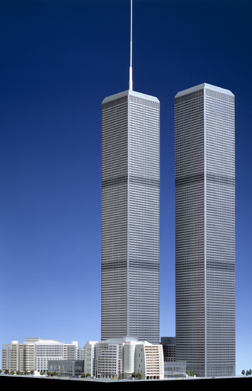Revisionist History


It’s been a while since I weighed in on the progress at Ground Zero, where things have been going less than swimmingly over the past few weeks. First, the NYPD requested that the Freedom Tower be redesigned according to their security guidelines, which require that the building be placed at least 100 feet back from any roadway in order to deter and deflect would-be truck bombings.
This raised the ire of George Pataki and the LMDC, who thought that the recommendations came a bit late (the NYPD claims its concerns were initially ignored). As it is, no steel has yet been ordered for the tower, and in light of these new developments it seems likely that when the design is finally ready to go into construction, both the tower we get and the overall planning of the site will have been changed -- for better or worse -- by important security considerations.
To make matters worse, the Donald took this opportunity to throw his support behind an alternate and unsanctioned plan for the WTC site by Kenneth Gardner and Herbert Belton, which calls for building updated replicas of the original twin towers on their original footprints, defying not only the terrorists but also the wishes of most 9/11 victims’ families, who have asked that the (already chosen) memorial design preserve the footprints. This is an alarmingly conservative approach to what most New Yorkers -- and people in general -- have recognized as a unique opportunity for optimistic renewal.
Aside from the obvious problems associated with ignoring the desires of victims’ families, this plan would also replace the office space of the original towers all at once. It is already clear that tenants willing to rent offices in newly high-risk Lower Manhattan are scarce (Goldman Sachs recently announced that they are pulling out of their plans to move in to one of the new buildings). Rebuilding both towers together assumes that they would be occupied immediately, while the Freedom Tower plan, however flawed, at least makes a provision for building the additional towers only as dictated by the demand for space.
Close examination of the “Twin Towers II” scheme also reveals the extent to which the original towers’ design has been changed: where the windows were once narrow and tall, presumably to make workers on the upper floors feel more at ease, the new towers would have more typical square office windows. Gone are the graceful proportions and slender window mullions emphasizing verticality, replaced by the kind of banal facade one might find in Houston, Denver, Atlanta, or any other place.
But my greatest problem with the new design has nothing to do with victims’ families, real estate demand, or the way the facade is detailed. To rebuild the towers more or less as they were is fundamentally an act not of defiance, but of denial: it says that nothing happened here, and our lives go on. Yes, we must show terrorists that they have done nothing to break our spirit or change our values, but we must also acknowledge the importance of what happened. I would much prefer to show my children two 200-foot squares and a gap in the skyline than two monolithic towers that are frustratingly different from their predecessors. How could one explain the latter? “Here stood two great towers, identical in nearly every respect to the ones you see now.” How are they different? How long before no one remembers what changed, or that it changed at all?
I do not believe that cities are static, singular things. They are dynamic and fluid, and are always contingent on the ebb and flow of human commerce and culture. That which is removed does not vanish completely, but resides forever in our memory, leaving incongruities on old maps and faint shadows on the sides of buildings. The reaction to tragedy in this context should be “We can do this better.”
There is nothing defeatist about that.

0 Comments:
Post a Comment
<< Home